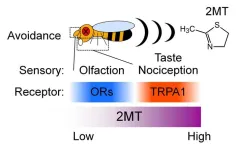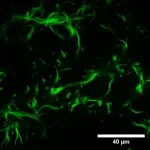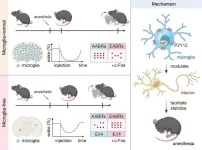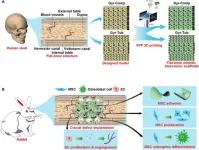(Press-News.org) Okazaki, Japan – crop damage in agriculture and the transmission of vector-borne diseases by insect pests have become worldwide threat nowadays. Chemical treatments such as insecticides and repellents have been a major strategy against insect pests for centuries. Due to limited understanding of mechanisms of insect avoidance behavior, however, development of insect repellents has been delayed. To discover compounds that effectively repel insect pests, it is important to focus on key molecules associated with sensory, particularly aversive, responses. In this study, researchers identified a compound that induces robust aversive responses through multiple sensory pathways in the fruit fly, Drosophila melanogaster.
Among sensory receptors, Transient Receptor Potential (TRP) cation channels play a key role in nocifensive behaviors to various stimuli in many insect species. Particularly, TRPA1 channel has been extensively studied as it is activated by various hazardous chemicals. Therefore, insect TRPA1 stimulants are promising leads for novel repellents with a broad spectrum. Takaaki Sokabe and his colleagues at the National Institute for Physiological Sciences/the Exploratory Research Center on Life and Living Systems (ExCELLS) found that 2-methylthiazoline (2MT), an analog of a volatile compound found in fox urine, repels flies effectively, and revealed the molecular and cellular mechanisms of 2MT-induced aversions in the fly. They recently published their findings in Frontiers in Molecular Neuroscience.
"2MT is reported to evoke innate fear responses in mice via TRPA1, therefore we expected that the chemical possibly have an aversive effect on insects,” Sokabe says. “And it worked terrifically more than our expectation.”
Fly’s avoidance behaviors revealed that 2MT stimulates multiple sensory modalities: 2MT vapor acts on odorant receptors (ORs) in an olfactory pathway, and direct contact to 2MT activates TRPA1 in taste and nociceptive pathways. This resulted in apparent escaping from chemical source of male flies and avoidance of egg laying of female flies. Furthermore, The researchers demonstrated that TRPA1 is activated by 2MT through the direct interaction of 2MT to specific two amino acids in TRPA1.
“The action of 2MT on multiple sensory pathways seems to be a key for its high effectiveness,” says Takaaki Sokabe. “Because the amino acids essential for TRPA1 activation are highly conserved across a wide range of insect species, including agricultural pests and disease vectors, it will be important to test 2MT on many other insect pests to evaluate the spectrum.”
This new work could promote the development of novel insect repellents by focusing on TRP channels and other types of receptors as promising targets.
END
Stinky, bitter, and painful: A novel insect repellent attacks multiple sensory pathways
Researchers from the National Institute for Physiological Sciences/the Exploratory Research Center on Life and Living Systems (ExCELLS) in Japan identified a TRPA1 stimulant acts as a novel insect repellent via bitter taste, nociceptive, and olfactory sen
2023-12-22
ELSE PRESS RELEASES FROM THIS DATE:
Microglia act as a “facilitator and stabilizer” for anesthesia
2023-12-22
Though it may be a surprise to the millions of people who undergo general anesthesia every year for medical procedures, the biological mechanism for how different anesthetics block consciousness is still not fully understood. However, researchers may be one step closer after uncovering the way small immune cells in the brain called microglia are impacted by general anesthesia.
The research was presented in a paper published in eLife on 22/Dec/2023.
“We found that microglia play an important role in regulating the body’s response to general anesthesia. ...
3D-printed flat-bone-mimetic bioceramic scaffolds for cranial restoration
2023-12-22
The cranial bone in the human body performs very important functions, such as protecting the brain and enabling the passage of the cranial nerves that are essential to physiological functioning. Critical-sized cranial defects can disrupt both the physical and psychological well-being of patients. Restoration of critical-sized cranial defects by cranioplasty is challenging for reconstructive surgeons, who prefer to use autologous bone grafts. The acquisition of autologous bone requires additional surgeries concomitant with risks such as free flap loss, infection, deep venous thrombosis, and nerve injury. These limitations necessitate the development ...
TTUHSC's Reddy elected fellow by the National Academy of Inventors
2023-12-22
P. Hemachandra Reddy, Ph.D., a professor in the Texas Tech University Health Sciences Center (TTUHSC) School of Medicine’s Department of Internal Medicine who has researched healthy aging, dementia and other neurodegenerative diseases for more than 20 years, recently was named to the 2023 class of Fellows for the National Academy of Inventors (NAI).
The NAI is a member organization comprised of U.S. and international universities and governmental and nonprofit research institutes with more than 4,600 individual inventor members and fellows spanning more than 300 institutions worldwide. ...
Light colour is less important for the internal clock than originally thought
2023-12-22
Vision is a complex process. The visual perception of the environment is created by a combination of different wavelengths of light, which are decoded as colours and brightness in the brain. Photoreceptors in the retina first convert the light into electrical impulses: with sufficient light, the cones enable sharp, detailed, and coloured vision. Rods only contribute to vision in low light conditions allowing for different shades of grey to be distinguished but leaving vision much less precise. The electrical nerve impulses are finally transmitted to ganglion cells in the retina and then via the optic nerve to the visual cortex in the ...
Scientists develop ‘flying dragon’ robot to fight fires from a distance
2023-12-22
Imagine a flying dragon that doesn’t spout fire, but instead extinguishes it with blasts of water. Thanks to a team of Japanese researchers, this new kind of beast may soon be recruited to firefighter teams around the world, to help put out fires that are too dangerous for their human teammates to approach.
The blueprint of this novel firefighter robot, called the Dragon Firefighter, has now been published in Frontiers in Robotics and AI. And as it has been published as Open Science, roboticists around the world may freely ...
Sunday sales reign supreme and other takeaways from review of farmers market transactions
2023-12-21
CORNELL UNIVERSITY MEDIA RELATIONS OFFICE
FOR RELEASE: Dec. 21, 2023
Kaitlyn Serrao
607-882-1140
kms465@cornell.edu
ITHACA, N.Y. – Cornell researchers partnered with New York livestock farmers to analyze transactions at farmers markets, finding that sales were better on Sundays, early in the morning, and during certain months of the year. The study, which researchers believe is the first peer-reviewed analysis of customer-level transaction data at farmers markets, gives new insights into how farmers can make markets more profitable for them.
The researchers and farmers used point-of-sale devices that record sales ...
Palliative care is underused for patients with malignant urinary obstruction
2023-12-21
Less than half of patients with malignant ureteral obstruction (MUO) – a serious complication of advanced cancer, with a poor prognosis – receive palliative care (PC) for their condition, reports a paper in the January issue of Urology Practice®, an Official Journal of the American Urological Association (AUA). The journal is published in the Lippincott portfolio by Wolters Kluwer.
Hospice care can promote patient comfort while avoiding aggressive and invasive treatments for MUO patients nearing the end ...
JCEHP supplement aims to disrupt assumptions about continuing professional development
2023-12-21
December 7, 2023 —The Journal of Continuing Education in the Health Professions (JCEHP) has published a supplement, "Conceptual Advances in Continuing Professional Development in the Health Professions," in which scholars of continuing professional development (CPD) creatively examine prevailing assumptions and propose new theoretical frameworks and empirical insights. Publication of the supplemental issue is supported by the Society for Academic Continuing Medical Education (SACME). JCEHP, the official journal of the Alliance for Continuing Education in the Health Professions, ...
Researchers awarded $3 million to develop AI to better detect aggressive prostate cancer
2023-12-21
Researchers at the UCLA Health Jonsson Comprehensive Cancer Center have received a five-year, $3 million grant from the National Cancer Institute to identify novel cancer biomarkers and develop AI that can detect and predict aggressive prostate cancer to help avoid unnecessary treatments and their associated negative side effects.
Despite recent advancements, prostate cancer remains a common and serious health issue for men, and current methods of screening and risk assessment can often lead to overdiagnosis and overtreatment. About 90% of people diagnosed with prostate cancer receive treatment, even though ...
GPCR structure: Research reveals molecular origins of function for a key drug target
2023-12-21
Through an international collaboration, scientists at St. Jude Children’s Research Hospital leveraged data science, pharmacology and structural information to conduct an atomic-level investigation into how each amino acid in the receptor that binds adrenaline contributes to receptor activity in the presence of this natural ligand. They discovered precisely which amino acids control the key pharmacological properties of the ligand. The adrenaline receptor studied is a member of the G protein-coupled receptor (GPCR) family, and this family is the target of one-third of all Food and Drug Administration (FDA)-approved drugs. Thus, understanding how ...
LAST 30 PRESS RELEASES:
58% of patients affected by 2022 mpox outbreak report lasting physical symptoms
Golden Gate method enables rapid, fully-synthetic engineering of therapeutically relevant bacteriophages
Polar weather on Jupiter and Saturn hints at the planets’ interior details
Socio-environmental movements: key global guardians of biodiversity amid rising violence
Global warming and CO2 emissions 56 million years ago resulted in massive forest fires and soil erosion
Hidden order in quantum chaos: the pseudogap
Exploring why adapting to the environment is more difficult as people age
Society for Laboratory Automation and Screening welcomes new scientific director: Madeline M. Farley, Ph.D.
Austrian cow shows first case of flexible, multi-purpose tool use in cattle
Human nasal passages defend against the common cold and help determine how sick we get
Research alert: Spreading drug costs over the year may ease financial burden for Medicare cancer patients
Hospital partnership improves follow up scans, decreases long term risk after aortic repair
Layered hydrogen silicane for safe, lightweight, and energy-efficient hydrogen carrier
Observing positronium beam as a quantum matter wave for the first time
IEEE study investigates the effects of pointing error on quantum key distribution systems
Analyzing submerged fault structures to predict future earthquakes in Türkiye
Quantum ‘alchemy’ made feasible with excitons
‘Revoice’ device gives stroke patients their voice back
USF-led study: AI helps reveal global surge in floating algae
New method predicts asthma attacks up to five years in advance
Researchers publish first ever structural engineering manual for bamboo
National poll: Less than half of parents say swearing is never OK for kids
Decades of suffering: Long-term mental health outcomes of Kurdish chemical gas attacks
Interactional dynamics of self-assessment and advice in peer reflection on microteaching
When aging affects the young: Revealing the weight of caregiving on teenagers
Can Canada’s health systems handle increased demand during FIFA World Cup?
Autistic and non-autistic faces may “speak a different language” when expressing emotion
No clear evidence that cannabis-based medicines relieve chronic nerve pain
Pioneering second-order nonlinear vibrational nanoscopy for interfacial molecular systems beyond the diffraction limit
Bottleneck in hydrogen distribution jeopardises billions in clean energy
[Press-News.org] Stinky, bitter, and painful: A novel insect repellent attacks multiple sensory pathwaysResearchers from the National Institute for Physiological Sciences/the Exploratory Research Center on Life and Living Systems (ExCELLS) in Japan identified a TRPA1 stimulant acts as a novel insect repellent via bitter taste, nociceptive, and olfactory sen







